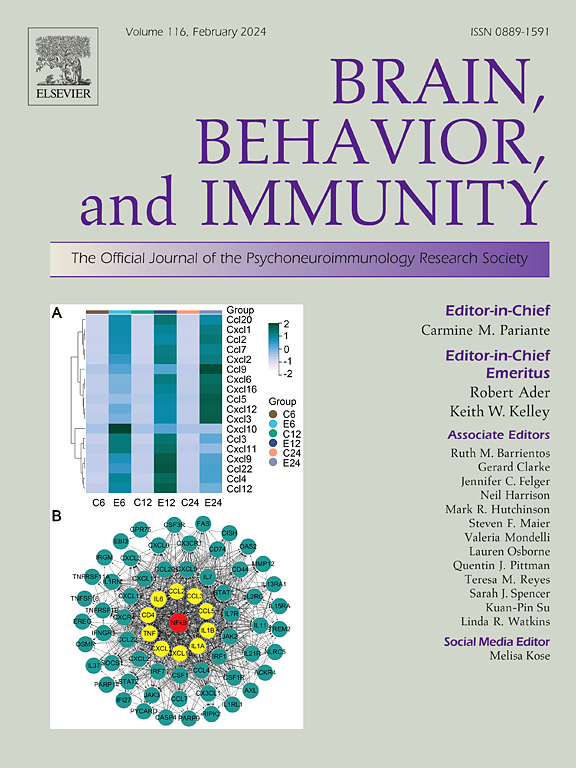Developmental stage of childhood trauma exposure and markers of inflammation at age 24
IF 8.8
2区 医学
Q1 IMMUNOLOGY
引用次数: 0
Abstract
Background
It is largely unknown whether the specific developmental stage at which childhood trauma occurs is related to inflammatory dysregulation in adulthood. We aimed to explore if trauma exposure at distinct developmental stages in childhood is differentially associated with the novel marker of chronic inflammation − soluble urokinase plasminogen activator receptor (suPAR), as well as with C-Reactive Protein (CRP) and Interleukin-6 (IL-6) levels in early adulthood.
Methods
Participants were drawn from the Avon Longitudinal Study of Parents and Children (n = 3272). The trauma variables represent any trauma exposure within early (0–4.9 years), middle (5–10.9 years), or late (11–17 years) childhood, and were derived from the responses to 121 questions collected via standardised questionnaires regarding traumatic experiences including physical abuse, sexual abuse, emotional abuse, emotional neglect, domestic violence, and bullying. Plasma suPAR, CRP and IL-6 samples were collected at age 24. Linear regression models assessed the relationship between trauma exposure at different developmental stages and the inflammatory markers, adjusting for sex, socio-economic status (SES) and child ethnicity. Latent profile analysis (LPA) identified age 24 inflammatory profiles and multinomial logistic regressions identified associations between childhood trauma and these latent groups.
Results
After adjustment for confounders, late childhood trauma was significantly associated with age 24 suPAR (β = 0.06, 95 % CI [.03, 0.1], p = 0.001), CRP (β = 0.09, 95 % CI [.01, 0.17], p = 0.04) and IL-6 (β = 0.1, 95 % CI [.02, 0.19], p = 0.02). The relationship between late trauma and suPAR survived additional adjustment for prior trauma (β = 0.06, 95 % CI [.01, 0.11], p = 0.03). Middle childhood trauma was significantly associated with IL-6 (β = 0.1, 95 % CI [.02, 0.18], p = 0.02). This attenuated after additionally adjusting for prior trauma (β = 0.11, 95 % CI [-0.09, 0.3], p = 0.29). There was little evidence of an association between early trauma and any inflammatory marker. Exposure to any trauma from 0-17 years was associated with elevated suPAR (β = 0.04, 95 % CI [.005, 0.07], p = 0.025) and IL-6 (β = 0.1, 95 % CI [.02, 0.18], p = 0.02) after adjustment for confounders. Additionally, LPA identified three distinct inflammatory profiles: 1. no inflammatory dysregulation; 2. elevated CRP and IL-6 levels; and 3. a high inflammatory group characterised by elevated levels of suPAR, CRP and IL-6. After adjustment for confounders, individuals with trauma either in early (RR = 2.31, 95 % CI [1.16, 4.6], p = 0.017), middle (RR = 2.72, 95 % CI [1.4, 5.29], p = 0.003) or late (RR = 3.37, 95 % CI [1.7, 6.64], p < 0.001) childhood had an increased risk of being in the high inflammatory group. The association between late childhood trauma and this high inflammatory group survived adjustment for prior trauma (RR = 3.69, 95 % CI [1.44, 9.47], p = 0.007).
Discussion
When the inflammatory markers were analysed independently, late childhood trauma showed a strong association with age 24 suPAR levels after adjusting for confounders and prior trauma. When the inflammatory markers were analysed in combination, those with late childhood trauma also were likely to have an elevated suPAR, CRP and IL-6 inflammatory profile. Collectively, the findings highlight the propensity of late childhood trauma (rather than early or mid-childhood trauma) for the dysregulation of suPAR in early adulthood and support the measurement of suPAR in combination with other markers to better characterise the effects of childhood trauma on adult inflammation. Future studies should use suPAR in combination with CRP and IL-6 to further explore the inflammatory contribution in the relationship between trauma and adverse health outcomes in adulthood.
求助全文
约1分钟内获得全文
求助全文
来源期刊
CiteScore
29.60
自引率
2.00%
发文量
290
审稿时长
28 days
期刊介绍:
Established in 1987, Brain, Behavior, and Immunity proudly serves as the official journal of the Psychoneuroimmunology Research Society (PNIRS). This pioneering journal is dedicated to publishing peer-reviewed basic, experimental, and clinical studies that explore the intricate interactions among behavioral, neural, endocrine, and immune systems in both humans and animals.
As an international and interdisciplinary platform, Brain, Behavior, and Immunity focuses on original research spanning neuroscience, immunology, integrative physiology, behavioral biology, psychiatry, psychology, and clinical medicine. The journal is inclusive of research conducted at various levels, including molecular, cellular, social, and whole organism perspectives. With a commitment to efficiency, the journal facilitates online submission and review, ensuring timely publication of experimental results. Manuscripts typically undergo peer review and are returned to authors within 30 days of submission. It's worth noting that Brain, Behavior, and Immunity, published eight times a year, does not impose submission fees or page charges, fostering an open and accessible platform for scientific discourse.

 求助内容:
求助内容: 应助结果提醒方式:
应助结果提醒方式:


